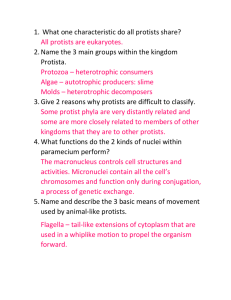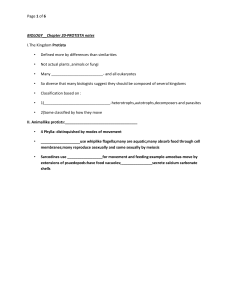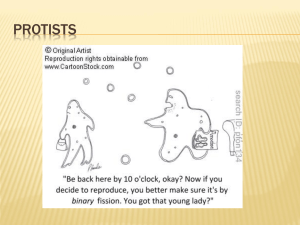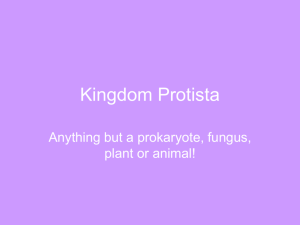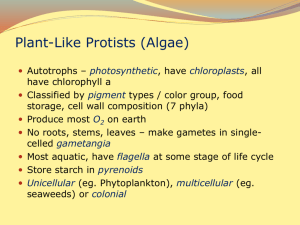Protists
advertisement
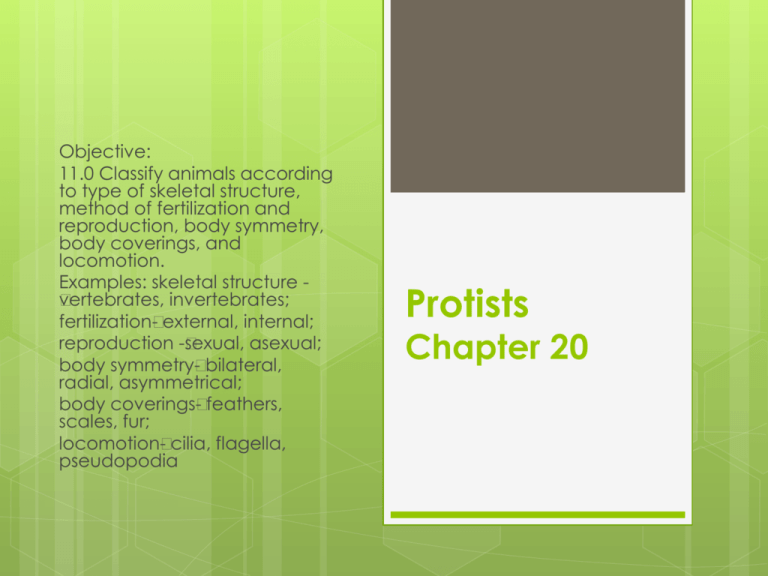
Objective: 11.0 Classify animals according to type of skeletal structure, method of fertilization and reproduction, body symmetry, body coverings, and locomotion. Examples: skeletal structure — vertebrates, invertebrates; fertilization— - external, internal; reproduction -— sexual, asexual; body symmetry— - bilateral, radial, asymmetrical; body coverings— - feathers, scales, fur; locomotion— - cilia, flagella, pseudopodia Protists Chapter 20 What is a Protist? Any eukaryote that is not an animal, plant, or fungus Most are unicellular, but not all Can be classified as animal-like, plant-like, or fungus-like Animal-like Protists (Section12-2) Heterotrophs 4 phyla, based on means of movement: Zooflagellates – swim through their aquatic environments using flagella Sarcodines – move via temporary cytoplasmic projections called pseudopods Ciliates – use _________ for feeding and movement Sporozoans – do not move on their own; are parasites Zooflagellates Can generally absorb food through their cell membranes Nutrients from decaying organic matter in water From the bodies of other organisms in which they live Reproduction can be asexual by mitosis and cytokinesis, or sexual by meiosis. Sarcodines Pseudopods are used for feeding and movement. EX: amoebas Reproduce asexually by mitosis and cytokinesis Source: http://www.enchant edlearning.com/subj ects/protists/amoeba .shtml Ciliates Cilia are short hair-like projections. The rapid beating of cilia propels ciliates through water. Most ciliates contain two different nuclei: Macronucleus – keeps multiple copies of the genes Micronucleus – contains a “reserve” copy of all the cell’s genes Obtain food by using cilia to sweep food into an indentation called the gullet Reproduce asexually by _____ and _____, and sexually by conjugation. Paramecium Source: http://rookc.pbworks.com/w/page/46197520/Paramecium Sporozoans Live as parasites on everything from worms to humans Reproduce by sporozoites Protists and Disease Malaria – caused by the sporozoan Plasmodium; spread by mosquito bites African sleeping sickness – caused by zooflagellate Trypanosoma; spread by tsetse fly bites Amebic dysentery – caused by parasitic Entamoeba Dysentery – flagellate Giardia Plant-Like Protists: Unicellular Algae (Section 20-3) Contain chlorophyll and carry out photosynthesis Commonly called “algae” Seven major phyla, classified according to a variety of cellular characteristics (types of chlorophyll or accessory pigments present): First 4 phyla are unicellular Last 3 contain many multicellular organisms 1. Euglenophytes Plant-like, but have 2 flagella (like ???) and no cell wall Eyespot – cluster of reddish pigment that helps organism find sunlight Reproduce asexually by binary fission Source:http://www.fcps.edu/islan dcreekes/ecology/euglena.htm 2. Chrysophytes “yellow plants” Includes yellow-green and goldenbrown algae Chloroplasts contain bright yellow pigment 3. Diatoms Produce thin, delicate cell walls rich in silicon (Si) – the main component of glass. Look like etched petri dishes Source: http://deepbluehome. blogspot.com/2011/0 1/psychedelicdiatoms.html 4. Dinoflagellates About half are photosynthetic; others are heterotrophs 2 flagella, which wrap around the the organism in grooves Reproduce asexually by binary fission Can luminesce when agitated Source:http://biology.un m.edu/ccouncil/Biology_ 203/Summaries/Protists .htm Source: http://w ww.ask nature. org/stra tegy/d8 51e351 13506b cf0219 e973da 169c29 Ecology of Unicellular Algae Compose most of the phytoplankton – plant microorganisms at the bottom of food chains Algal blooms (“red tide”) – Protists can break down sewage in water Excessive waste creates large populations of euglenophytes, which deplete nutrients in the water. When they die, they can deplete oxygen supplies needed by other organisms. Plant-like Protists: Red, Brown, and Green Algae (Section 20-4) Mostly multicellular Reproductive cycles similar to plants Many with cell walls and photosynthetic pigments identical to plants Red Algae Phylum Rhodophyta (“red plants”) Contain chlorophyll and reddish accessory pigments called phycobilins, which can absorb blue light, allowing them to harvest light energy at great depths Can actually be green, purple, or redish-black in color Play a role in coral reef formation Lack flagella and centrioles Brown Algae Phylum Phaeophyta (“dusky plants”) Contain chlorophyll and c, as well as a brown accessory pigment (fucoxanthin) Dark yellow-brown color EX: giant kelp Source:http://landsat.gsfc.nasa.gov/news/newsarchive/sci_0033.html Green Algae Phylum Chlorophyta (“?????”) Same photosynthetic pigment and cell wall composition as plants Contain chloroplast a and b Life cycles of many include both a diploid and a haploid generation (“alternation of generations”) Alternation of Generation Source: http://moodle.rockyvi ew.ab.ca/mod/book/v iew.php?id=58103&c hapterid=21008 Fungus-like Protists (Section 20-5) Fungi Both Cell walls made of chitin Fungus-like Protists Heterotrophs; Absorb nutrients from dead/decaying matter Have centrioles Molds Slime Molds: Cellular slime molds – individual cells remain distinct (separated by cell membranes) throughout life Acellular slime molds – pass through a life stage in which cells fuse to form large cells with many nuclei Water Molds: Thrive on dead or decaying matter in water OR are plant parasites on land EX: white fuzz on a dead fish in the water
